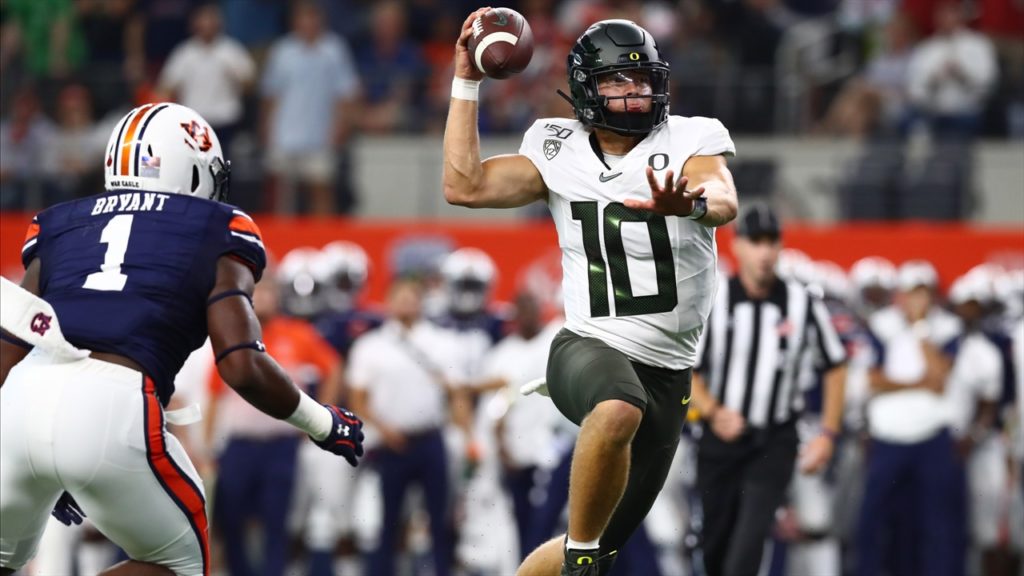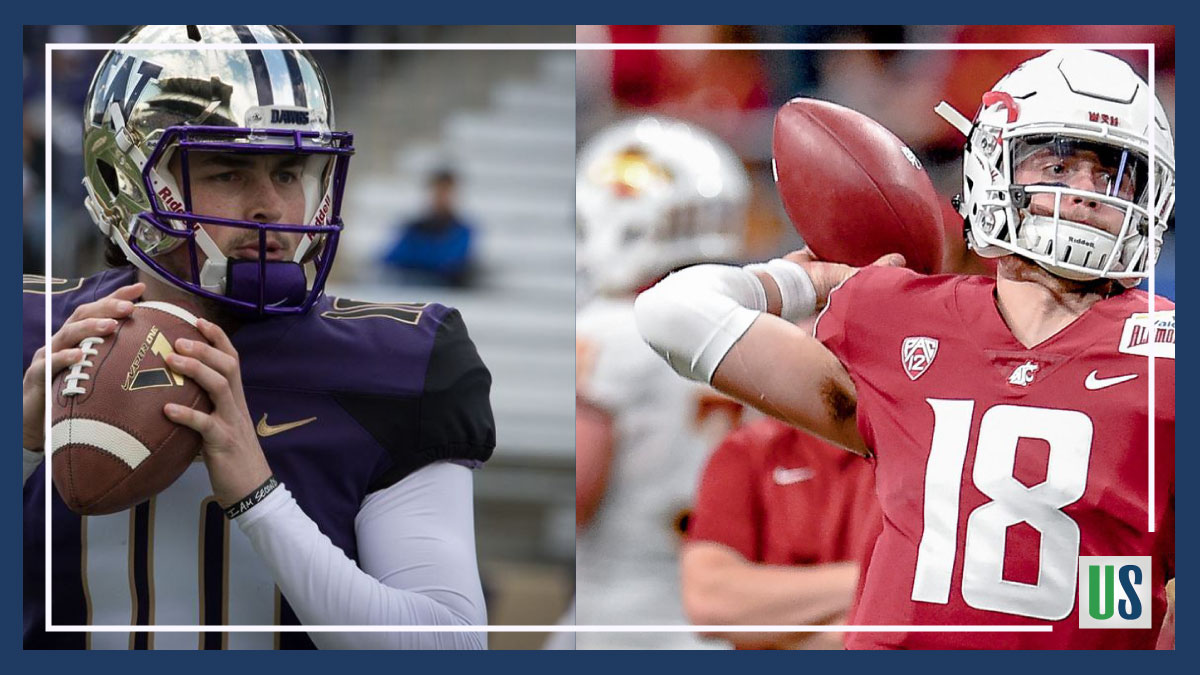Evergreen State Football Flexes Their Strength
An apple a day keeps the doctor away. In the state of Washington, the UW football and WSU football teams got off to hot starts, offenses clicking in blowout wins against Eastern Washington and New Mexico State. Overall, Washington and Washington State outscored their opponents 105-21. It was an excellent start to the season for Evergreen State Football fans and teams alike. With each game in the books, here are the big takeaways.
Check back every Tuesday for a new edition of Forever Evergreen.
Quarterbacks Jacob Eason and Anthony Gordon Set the Field Ablaze
Wow. Could it have played out any better for Eason and Gordon in their openers? Washington State Football quarterbacks are the best of the bunch (minus Justin Herbert obviously).
Jacob Eason
Eason, in his debut, set the record for the most passing yards in a UW football debut with 349 yards. His 4 touchdowns were also the most in a UW opener since Brock Huard in 1998. He led the Huskies to touchdowns on their first three drives and opened a 21-0 lead. As a former number one recruit, Eason lived up to the hype and put all the other Jake quarterbacks to shame.
Additionally, Eason displayed both arm-strength and touch. Though players and beat reporters talked up his arm strength over spring and summer, it was nice to see how it played out in a game. He made 50-plus yard throws look easy. And while his 50-yard touchdown to Andre Baccellia was impressive, it was not nearly as impressive as his incomplete pass to Aaron Fuller. After an awkward snap, Eason somehow managed to heave a 60-yard bomb to Fuller. Though it sailed over his intended receiver (possibly due to Fuller slowing down), it nonetheless displayed quick decision-making and natural arm-strength. All in all, Eason looked good.
Anthony Gordon
Not to be outdone by his Puget Sound rival, Anthony Gordon made things look easy. In less than three quarters, Gordon lit up New Mexico State for 420 yards and 5 touchdowns. Yes, the Mike Leach Air Raid Offense makes the quarterback’s job easier, but not that easy. In fact, Gordon ended the first half with an insane line: 22 for 23, 330 yards and 4 touchdowns. Unbelievable.
In his impressive victory, Gordon completed passes to 9 different receivers and threw touchdowns to 4 different ones. He spread the ball around well. Gordon was decisive, precise, and carved through New Mexico State. He led the Cougars to a touchdown on each of their five, first half drives. Though he’s a redshirt senior without any Pac-12 experience prior to this game, he let his name be known. Anthony Gordon and Mike Leach made their case for the Pac-12’s best offense.
Other Offensive Highlights
UW Seniors Lead the Team in Receiving
Seniors Hunter Bryant (TE), Andre Baccellia (WR), Aaron Fuller (WR) and Chico McClatcher (WR) led the team in receptions, receiving yards and receiving touchdowns. It was a senior day all the way. Each notched at least five receptions from Jacob Eason. It appears that Eason and coach Peterson are completely fine with riding the talent and experience of their senior playmakers in the pass game.
UW and WSU Have Breakout Running Backs
Richard Newton came out of nowhere. On his first collegiate touch, Newton took it 23 yards to the end zone. He continued his redshirt freshman debut and totaled 91 yards on 12 carries. At 6-foot, 210lbs, Newton was difficult to tackle and displayed excellent rushing instincts and power.
Max Borghi of WSU displayed efficiency and explosiveness. On just 10 carries, Borghi broke the century mark with 128 rushing yards. As many already know, Borghi showed an ability to catch passes last season. With his impressive opener as the leading rusher, Borghi looks to be the Pac-12’s leader in yards from scrimmage at the end of the season.
Will these Evergreen State Football running backs be the best in the Pac-12?
Defenses Bend, But Don’t Break with the New Guys
Though the scoreboard would deceive most, there was a lot that UW football and WSU football could have done better.
UW allowed 274 yards and two touchdowns. Additionally, they let the Eagles march down the field with 79 and 84 back-to-back drives. With that being said, Chris Peterson rotated in a variety of redshirt and true freshmen on defense. Cam Williams, Laiatu Latu, Alphonzo Tuputala, Trent McDuffie, Asa Turner, Jackson Sirmon, M.J. Tafisi, Tuli Letuligasenoa, Sam Taimani, Faatui Tuitele, Jacob Bandes, Noa Ngalu all got snaps. So obviously there is room for growth. Additionally, the Dawgs notched 4 sacks, 9 tackles for a loss, and 1 safety. They also allowed just 2.1 yards per carry to the Eagles. All in all, it was a promising day for Chris Peterson’s defense. It looks like Peterson has once again recruited and schemed a top defense for the Huskies.
WSU on the other hand, looked both shaky and solid. Yes, they held New Mexico State to just one touchdown. However, they gave up the touchdown just after Anthony Gordon marched WSU down the field. They let New Mexico tie the game 7-7 right away. Additionally the Cougars’ defense allowed nearly 200 yards in the first half. Their defensive line was pushed around more than the scoreboard showed. But, WSU did an excellent job making adjustments in the second half and continuing their dominance. Overall, WSU’s defensive line is the most suspect. They need to find quality players that can penetrate and make consistent, defensive stops.

The Rest of the Bunch
Apart from Utah, Washington and Washington State had the best weekends. It was a very good week for Evergreen State football fans. Unlike them, Oregon had a rough time. After leading by 15 in the third quarter, buckled to Auburn. They lost the biggest Pac-12 game of the week (and possibly the season). This extended the Pac-12’s losing streak to 10 against ranked, SEC opponents. As much as it helps Washington and Washington State in their Pac-12 rankings, Oregon’s loss hurts the Pac-12 conference overall.
Overall, the Pac-12 went 1-2 against Power Five teams, 5-2 against Group of Five (including independent BYU and New Mexico State) teams and 2-0 against FCS teams. Not inspiring. If the Pac-12 wants to be taken seriously as a conference, teams need to win every out of conference game. It obviously doesn’t help when Oregon collapses late to Auburn. But UCLA, Oregon State, USC and Cal looked like they kept last season’s issues. They were lackluster. Additionally, USC lost their quarterback to a knee injury. J.T. Daniels had to be carted off. Pac-12 teams needed to step up this season, and many teams aren’t.
As the dust settles from Week 1 of the Pac-12, Evergreen State Football appears primed for the top-spot. Stanford’s schedule is too difficult. USC has a difficult schedule, displayed poor play/judgement and lost their quarterback. Colorado needs a defense. Cal needs an offense. Oregon lost when it counted most.
It’s a year for the Evergreen State to claim the top spots. Though, Utah was impressive and Oregon could bounce back. If Oregon proves to be just shy of elite, Utah and WSU can each attempt to leap UW this season.



